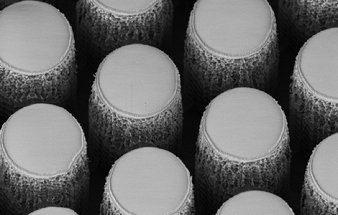This project has both an experimental and a modeling character, comprising an experimentally study of the electrical properties of modified silicon surfaces and the impact on electroosmotic flow behavior and mass transfer. Unique flow profiles are generated in confined spaces, capable of enhancing mass transfer and minimizing dispersion. The achievable flow configurations are studied by computational fluid dynamics simulations as well as experimentally with a microscopy setup and in-house developed detection. Devices are studied, designed and manufactured in the cleanroom. In the second stage of the project, co-operation takes place with a PhD student who will implement the developed technology for microfluidic applications such as chromatography, a field wherein this developed technology will be key to increase the separation performance by orders of magnitude.

SEM images of a porous shell micro pillar array as part of a microfluidic system for separation by chromatography. From: W. de Malsche et al., (2007), Integration of porous layers in ordered pillars for liquid chromatography, Lab Chip, 7, 1705-1711
This is a joint project between the Free University of Brussels (supervision of Prof. Wim De Malsche) and the Mesa+ Institute for Nanotechnology (co-supervision of Prof. Jan Eijkel) and is sponsored by an ERC starting grant
Contact information:

Christina Tiflidis
c.tiflidis@utwente.nl

Wim de Malsche (Free University of Brussels)
wdemalsc@vub.ac.be
Wouter Olthuis (University of Twente)
w.olthuis@utwente.nl
Jan Eijkel (University of Twente)
j.c.t.eijkel@utwente.nl
